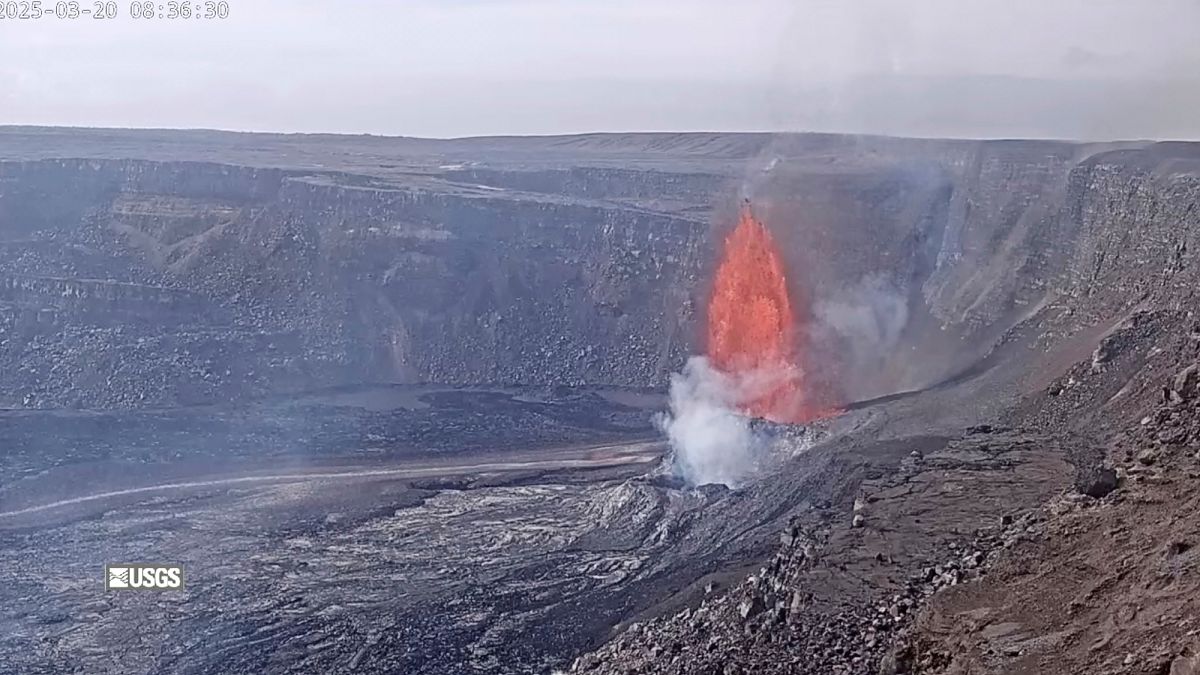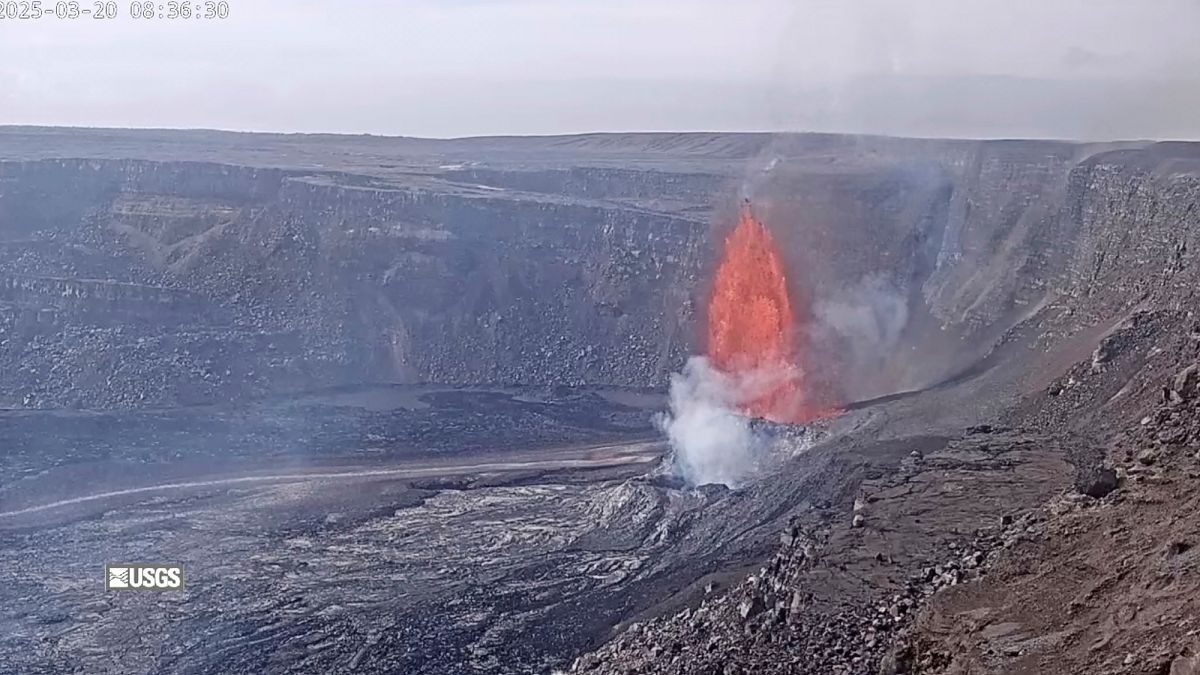Travel
Hawaii’s Kilauea volcano erupts again, no threat to residents

Hawaii’s Kilauea volcano erupts again, no threat to residents

Lava fountains shoot up during the March 20, 2025 episode in the ongoing eruption of Kilauea. – Copyright United States Geological Survey via AP
Copyright United States Geological Survey via AP
By Euronews with AP
Published on •Updated
Share this article
Copy/paste the article video embed link below:Copied
Kilauea ramped up its surface activity on Tuesday when lava began pouring out of a vent in its caldera.
Lava began bubbling out of Hawaii’s most active volcano once again on Tuesday as Kilauea’s sporadic eruption resumed.
The eruption restarted at midday when when molten rock began pouring out of a vent in Kilauea’s summit, the Hawaiian Volcano Observatory said in a statement. The lava was contained within the caldera inside Hawaii Volcanoes National Park and wasn’t affecting any residential areas.
The volcano on the Big Island of Hawaii has been erupting on-and-off since 23 December. It has shot tall fountains of lava high into the air, spilling molten rock across the caldera floor each time it comes back to life.
The spectacle is a popular attraction for tourists.
The current episode is the 15th of the current eruption. The shortest of the previous episodes lasted 13 hours and the longest for eight days; while pauses in between episodes have ranged from 24 hours to 12 days.
Kilauea is one of six active volcanoes in Hawaii, including one submerged underwater. The largest is Mauna Loa, which is also on the Big Island and which erupted in 2022.
Watch the video in the player above to find out more.
Go to accessibility shortcuts
Travel
‘Leave them where they belong’: Bruges implores tourists to stop stealing cobblestones
Tourists have been caught smuggling all kinds of stolen souvenirs home from holidays, from artefacts picked up in Pompeii to sand from Italy’s famous pink beach on the island of Sardinia.
The Belgian city of Bruges is the latest victim of keepsake crime, but the item visitors have taken a fancy to is unexpected.
The city council has reported the theft of dozens of cobblestones from the city centre, and suspects tourists are the culprits.
Tourists suspected of pilfering Bruges’ cobblestones
Bruges’ cobblestones are increasingly being pilfered from well-known spots in the UNESCO-designated historic centre, public property councillor Franky Demon reported this week.
“At iconic locations such as Minnewater, Vismarkt, Markt and Gruuthusemuseum, it is estimated that 50 to 70 pieces of cobblestone disappear every month. And that number could be even higher,” Demon told press.
“The phenomenon increases significantly, especially during busy tourist periods such as spring and summer,” he added.
For this reason, authorities suspect visitors are pocketing the stone as souvenirs.
‘Leave that cobblestone where it belongs’
As well as damaging a valuable part of the city’s heritage, the stolen stones have created safety issues.
The gaps from removed stones present trip hazards for pedestrians – and are costly to repair.
“It’s unfortunate that our employees constantly have to go out to fix potholes and loose stones. This causes a lot of additional work and costs: about 200 euros per square metre of reconstruction,” explained Demon.
The councillor urged visitors to respect the historical environment of Bruges.
“We simply ask for respect. Anyone walking through Bruges crosses centuries of history. Leave that cobblestone where it belongs,” he said.
Bruges’ cobblestones are apparently not the only sought-after street souvenir.
Along the famous Paris-Roubaix cycling route, tourists are known to pilfer parts of the pavement.
While Rome’s iconic ‘sampietrini’ – cobblestones made of solidified lava – have also disappeared into suitcases over the years.
Travel
‘Inequality and infinite growth’: Canary Islands anti-tourism protests reignite amid record arrivals
This weekend, residents of Spain’s Canary Islands are coming out in force to protest against mass tourism.
People on the archipelago have been growing increasingly vocal about its struggles with visitor numbers.
Last year, locals held multiple protests to highlight overtourism’s strain on local infrastructure and housing availability. They look set to continue again this summer as residents say little has been done to tackle the problem.
Protests planned across Spain against overtourism
On Sunday, 18 May, residents of the Canary Islands will take to the streets to join protests organised by campaign group Canarias tiene un límite (The Canary Islands have a limit).
Demonstrations will be held on all the islands of the archipelago as well as in several cities across Spain.
Protests will begin at 11 am on the seven main Canary Islands – El Hierro, La Palma, La gomera, Tenerife, Gran Canaria, Lanzarote and Fuerteventura – and at 12pm on mainland cities including Barcelona, Madrid and Valencia.
Residents in the German capital of Berlin are also planning to take to the streets in solidarity.
Why are residents of the Canary Islands protesting?
The organisers say they are protesting to oppose the current economic model “based on overtourism, speculation, inequality and the infinite growth on very limited land”.
Instead, they want a transition to a people-centred, environmentally responsible model that respects the archipelago’s ecological and social needs.
Specifically, they are calling for a halt to destructive hotel projects across the islands and the building of a motor circuit on Tenerife; a moratorium on new tourist developments; guaranteed access for residents to healthcare and housing; and a functional ecological tourist tax.
The group also wants the immediate introduction of measures to curb marine pollution and the creation of an environmental restoration law.
Canary Islands receive record number of tourists in March
Earlier this month, authorities announced that the Canary Islands received more than 1.55 million foreign visitors in March, up 0.9 per cent on the record set in the same month last year.
The figures were released by the Canary Islands National Statistics Institute (INE), which added that the total number of international tourists for the first quarter of 2025 was 4.36 million, an increase of 2.1 per cent year-on-year.
The tourist influx comes despite dozens of protests staged last year by Canary Island residents against mass tourism.
Similar demonstrations have already taken place this year. Over Easter, around 80,000 hospitality workers in Tenerife, La Palma, La Gomera and El Hierro walked out in a dispute with unions over pay.
Travel
Crete earthquake: Is it safe to travel to the Greek island following tsunami warning?
A 6.0 magnitude earthquake struck off the coast of the Greek island of Crete early this morning, Wednesday 14 May.
Authorities issued a tsunami alert in the area shortly after the tremor, which was felt as far away as Israel, Syria and Egypt.
Tourists are being warned to stay away from coastal areas in the popular holiday spot.
Here is the latest travel information from the local government.
Tourists in Crete urged to move away from coastlines
The earthquake was at a depth of 35 kilometres with its epicentre near the islands of Kasos and Karpathos in the Aegean Sea.
Greece’s Ministry for Climate Crisis and Civil Protection issued a precautionary tsunami warning for the area, including the east coast of Crete and the island of Rhodes.
Authorities urged residents and tourists on the island to keep away from the coastline and move to higher ground.
“A magnitude 5.9 earthquake occurred 48km SE of Kasos. Risk of possible Tsunami in your area,” the Ministry posted on its X account this morning. The magnitude was later updated to 6.0.
“Move away from the coast immediately. Follow the instructions of Local Authorities.”
Samaria Gorge, one of Crete’s most popular hiking routes, is temporarily closed as officials check for any damage done to the route.
“The Natural Environment and Climate Change Organisation announces that due to the earthquake that occurred today south of Kasos, the gorge will remain closed to visitors in order to check the route for possible rockfalls,” authorities said. “A further announcement will be made late this afternoon.”
Crete earthquake: Is it safe to travel and am I entitled to compensation?
Foreign governments have not issued travel advisories as yet, so it is currently still considered safe to visit Greece and its islands.
This also means that, should you choose not to go ahead with your trip, you are unlikely to receive compensation.
Depending on your travel insurance policy, you may be able to receive a refund for some or all of your trip if it includes compensation for cancellations due to natural disasters. Check with your provider and read your terms and conditions carefully.
There have been no reports so far of injuries or major damage from the earthquake, but authorities are monitoring the situation closely and have warned people should remain vigilant.
If you are on holiday in or about to travel to Crete, Kasos or Karpathos, make sure you stay up to date with the latest information.
Crete and its surrounding region are considered one of Europe’s most seismically active zones.
In October 2021, a 6.3 magnitude earthquake shook the island just weeks after another tremor killed one person and injured several others.
-

 EU & the World5 days ago
EU & the World5 days agoWho Is Valeria Marquez? About the Influencer Who Was Shot During Livestream
-

 EU & the World3 days ago
EU & the World3 days agoChris Brown Tour 2025: Updates on Concert Dates, Cities, Ticket Prices & More
-

 EU & the World6 days ago
EU & the World6 days agoCardi B & Offset’s Relationship Timeline: From Marriage To Cheating Drama & Split
-

 Politics7 days ago
Politics7 days agoEU Assesses Support for Ukrainian Refugees: Challenges and Flexibility in Humanitarian Response
-

 EU & the World4 days ago
EU & the World4 days agoWho Is Ben Cohen? About the Ben & Jerry’s Co-Founder Who Was Arrested During Senate Hearing
-
Travel5 days ago
Crete earthquake: Is it safe to travel to the Greek island following tsunami warning?
-

 EU & the World2 days ago
EU & the World2 days agoJosh Freese: 5 Things to Know About the Former Foo Fighters Drummer
-

 Entertainment3 days ago
Entertainment3 days agoEurovision 2025: Music, Politics, and the Final 26 Set Amid Controversy and Spectacle









